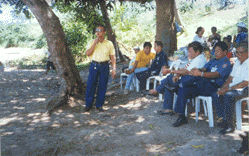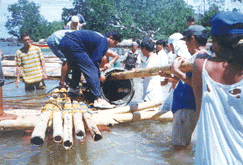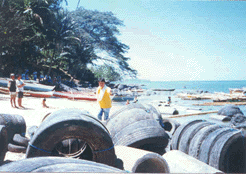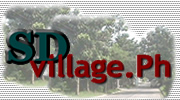
Community
Profiling
After the Memorandum of Agreement was signed between the concerned Barangay Captains
and the LGSP, TOUCH Foundation conducted a Rapid Rural Appraisal (RRA) to identify
community needs, analyze potential problems and difficulties as well as validate and
update the barangay profiles. This activity gave them valuable information about the
community which helped in the design of project implementation.
 Overcoming Community Resistance Through
Education
Overcoming Community Resistance Through
Education
At the outset, there was reluctance in the community in terms of cooperating with the
Project. There was that usual notion that protecting the Bay would mean stopping their
fishing activities which comprise their main source of income. In response to this,
intensive information dissemination, study tours, training, ecological awareness and
skills development activities were conducted. Through these, the community was able to
better understand the purpose and objectives of the Project. In time, the community
started to appreciate the value of sustainable utilization of the coastal resources.
Building Local SD Constituency
Through consistent dialogue with the community, it was realized that the existence of a
viable local institutions which will manage the project is crucial in its effective
implementation. With this end-in-view, a multisectoral Steering Committee (SC) chaired by
the Municipal mayor was created to monitor and evaluate the project, recommend and
implement approved local ordinances related to SCRM, and conduct public hearings. The SC
is supported by a Technical Working Group (TWG) which also coordinates with the Philippine
National Police (PNP) and the coast guards for coastal monitoring and registration, among
others. The SC and TWG also comprise the Balingoan LGP Project Management Team (BLPMT).
In both Lapinig and Mantangale, respective Barangay Fisheries and Aquatic Resources
Management Council (BFARMC) with representatives from various sectors were created. Its
members are mostly barangay-based individuals involved in day-to-day activities in coastal
waters. They are tasked to maintain and manage the project, especially the livelihood and
resource conservation activities.
Fish wardens were deputized for the Bantay Dagat. This was
done in coordination with the provincial office of the Bureau of Fisheries and Aquatic
Resources. Capability building activities were undertaken to equip fisherfolks with the
knowledge, skills, and attitude necessary in apprehending illegal fishery activities.
Around 46 fish wardens including women and children are proud and active in their new role
serving as "informers" of violators. Violators coming from other coastal
communities, undergo a two-hour seminar on the Fisheries Code and SCRM, among others.
Linkages and Partnerships
All organizations that have involvement in the implementation of the activities under
the SCRM are linked with each other. It is a usual practice for them to regularly hold
joint meetings and activities to cultivate openness among the partners in communicating,
suggesting ideas, and airing organizational and operational problems.
Linkages with local business groups engaged in resort management have also been
established. Further, since Gingoog Bay is a whale shark haven, Task Force Barracuda was
created to protect the whale sharks. The Whale Shark Spotters Association was also formed
to help conserve and protect the Bay’s marine life and natural resources by promoting
environmental awareness and monitoring whale sharks and other marine mammals in the Bay.
Observing Transparency and Participatory Approach
One of the principles adhered to by the SCRM is participatory democracy. It is a common
practice that before conducting any activity, public dialogues and consultations are held
to ensure maximum participation and cooperation. Decision-making is through consensus
building. The role of women has been intricately integrated in the activities of the
project as well as in the opportunities that stem from it.
Conservation and Rehabilitation Activities (Technology and Livelihood)
Reforestation of an initial eight hectares of mangrove area in Lapinig was done by 113
men and women volunteers led by the Barangay Captain. This encouraged the other nearby
barangays to follow suit also led by their respective Barangay Captains. Through their pahino
system (bayanihan), they constructed and installed some 100 artificial reef modules
made of culverts and used tires in areas found to be in critical condition.
The declaration of a 10-hectare marine sanctuary in Lapinig limited fishing activities
in some portions of the community’s coastal waters. Thus, an alternative livelihood
had to be provided for these fisherfolks. This situation was remedied by establishing Fish
Aggregating Devices or FADs. These FADs are shelters made of coconut and palm leaves
attached to about 10 meters underwater from the base of the FAD that serve as breeding
ground and harborage for fish. These FADs lessened the pressure of fishing activities in
the shallow portions of the coastal area while serving as an alternative fishing grounds
by maximizing fish catch especially for fisherfolks who do not own pumpboats. At least six
FADS have been constructed and installed by the community and its partners including a
private beach resort that lent motorized boats to haul the FADs from the coast to the main
sea at 26-30 fathoms deep.

